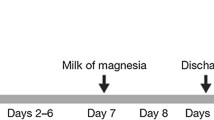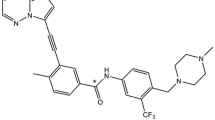Abstract
Purpose
This metabolite profiling and identification analysis (part of a phase I absorption, distribution, metabolism, and excretion study) aimed to define biotransformation pathways and evaluate associated inter-individual variability in four patients with advanced solid tumors who received [14C]-ixazomib.
Methods
After administration of a single 4.1-mg oral dose of [14C]-ixazomib (total radioactivity [TRA] ~ 500 nCi), plasma (at selected timepoints), urine, and fecal samples were collected before dosing and continuously over 0–168-h postdose, followed by intermittent collections on days 14, 21, 28, and 35. TRA analysis and metabolite profiling were performed using accelerator mass spectrometry. Radiolabeled metabolites were identified using liquid chromatography/tandem mass spectrometry.
Results
Metabolite profiles were similar in plasma, urine, and feces samples across the four patients analyzed. All metabolites identified were de-boronated. In AUC0–816 h time-proportional pooled plasma, ixazomib (54.2% of plasma TRA) and metabolites M1 (18.9%), M3 (10.6%), and M2 (7.91%), were the primary components identified. M1 was the major metabolite, contributing to 31.1% of the 76.2% of the total dose excreted in urine and feces over 0–35-day postdose. As none of the identified metabolites had a boronic acid moiety, they are unlikely to be pharmacologically active.
Conclusions
Hydrolytic metabolism in conjunction with oxidative deboronation appears to be the principal process in the in vivo biotransformation pathways of ixazomib. The inference of formation-rate-limited clearance of ixazomib metabolites and the inferred lack of pharmacologic activity of identified circulating metabolites provides justification for use of parent drug concentrations/systemic exposure in clinical pharmacology analyses.

Reproduced from Gupta et al. [8] under the Creative Commons license: https://creativecommons.org/licenses/by-nc/4.0/legalcode



Similar content being viewed by others
References
Chauhan D, Tian Z, Zhou B et al (2011) In vitro and in vivo selective antitumor activity of a novel orally bioavailable proteasome inhibitor MLN9708 against multiple myeloma cells. Clin Cancer Res 17(16):5311–5321
Kupperman E, Lee EC, Cao Y et al (2010) Evaluation of the proteasome inhibitor MLN9708 in preclinical models of human cancer. Cancer Res 70(5):1970–1980
Lee EC, Fitzgerald M, Bannerman B et al (2011) Antitumor activity of the investigational proteasome inhibitor MLN9708 in mouse models of B-cell and plasma cell malignancies. Clin Cancer Res 17(23):7313–7323
Merlini G, Sanchorawala V, Zonder JA et al (2014) Long-term outcome of a phase 1 study of the investigational oral proteasome inhibitor (PI) ixazomib at the recommended phase 3 dose (RP3D) in patients (pts) with relapsed or refractory systemic light-chain (AL) amyloidosis (RRAL). Blood 124(21):3450–3450
Sanchorawala V, Palladini G, Kukreti V et al (2017) A phase 1/2 study of the oral proteasome inhibitor ixazomib in relapsed or refractory AL amyloidosis. Blood 130(5):597–605
Gupta N, Diderichsen PM, Hanley MJ et al (2017) Population pharmacokinetic analysis of ixazomib, an oral proteasome inhibitor, including data from the phase III TOURMALINE-MM1 study to inform labelling. Clin Pharmacokinet 56(11):1355–1368
Gupta N, Hanley M, Venkatakrishnan K et al (2018) Effects of strong CYP3A inhibition and induction on the pharmacokinetics of ixazomib, an oral proteasome inhibitor: results of drug–drug interaction studies in patients with advanced solid tumors or lymphoma and a physiologically based pharmacokinetic analysis. J Clin Pharmacol 58(2):180–192
Gupta N, Zhang S, Pusalkar S et al (2018) A phase I study to assess the mass balance, excretion, and pharmacokinetics of [14C]-ixazomib, an oral proteasome inhibitor, in patients with advanced solid tumors. Investig New Drugs 36(3):407–415
Hamilton RA, Garnett WR, Kline BJ (1981) Determination of mean valproic acid serum level by assay of a single pooled sample. Clin Pharmacol Ther 29(3):408–413
Roffey SJ, Obach RS, Gedge JI et al (2007) What is the objective of the mass balance study? A retrospective analysis of data in animal and human excretion studies employing radiolabeled drugs. Drug Metab Rev 39(1):17–43
Penner N, Xu L, Prakash C (2012) Radiolabeled absorption, distribution, metabolism, and excretion studies in drug development: why, when, and how? Chem Res Toxicol 25(3):513–531
United States Food & Drug Administration (2015) NINLARO (ixazomib) capsules, for oral use. United States prescribing information, November 2015. https://www.accessdata.fda.gov/drugsatfda_docs/label/2015/208462lbl.pdf
Dueker SR, Vuong le T, Lohstroh PN et al (2011) Quantifying exploratory low dose compounds in humans with AMS. Adv Drug Deliv Rev 63(7):518–531
Arjomand A (2010) Accelerator mass spectrometry-enabled studies: current status and future prospects. Bioanalysis 2(3):519–541
Kim SH, Chuang JC, Kelly PB et al (2011) Carbon isotopes profiles of human whole blood, plasma, red blood cells, urine and feces for biological/biomedical 14C-accelerator mass spectrometry applications. Anal Chem 83(9):3312–3318
Beumer JH, Garner RC, Cohen MB et al (2007) Human mass balance study of the novel anticancer agent ixabepilone using accelerator mass spectrometry. Investig New Drugs 25(4):327–334
Lappin G, Garner RC (2003) Big physics, small doses: the use of AMS and PET in human microdosing of development drugs. Nat Rev Drug Discov 2(3):233–240
Vogel JS, Lohstroh P, Keck B et al (2011) Quantitative drug metabolism with accelerator mass spectrometry. In: Mass spectrometry in drug metabolism and disposition. Wiley, New York, pp 525–566. https://doi.org/10.1002/9780470929278.ch16
United States Food & Drug Administration (2018) Guidances (drugs). https://www.fda.gov/Drugs/GuidanceComplianceRegulatoryInformation/Guidances/
European Medicines Agency (2008) ICH topic S9 nonclinical evaluation for anticancer pharmaceuticals. https://www.ema.europa.eu/docs/en_GB/document_library/Scientific_guideline/2009/09/WC500002867.pdf
Groll M, Berkers CR, Ploegh HL et al (2006) Crystal structure of the boronic acid-based proteasome inhibitor bortezomib in complex with the yeast 20S proteasome. Structure 14(3):451–456
Gupta N, Yang H, Hanley MJ et al (2017) Dose and schedule selection of the oral proteasome inhibitor ixazomib in relapsed/refractory multiple myeloma: clinical and model-based analyses. Target Oncol 12(5):643–654
Gupta N, Labotka R, Liu G et al (2016) Exposure-safety-efficacy analysis of single-agent ixazomib, an oral proteasome inhibitor, in relapsed/refractory multiple myeloma: dose selection for a phase 3 maintenance study. Investig New Drugs 34(3):338–346
Gupta N, Hanley MJ, Venkatakrishnan K et al (2016) Pharmacokinetics of ixazomib, an oral proteasome inhibitor, in solid tumour patients with moderate or severe hepatic impairment. Br J Clin Pharmacol 82(3):728–738
Gupta N, Zhao Y, Hui AM et al (2014) Switching from body surface area-based to fixed dosing for the investigational proteasome inhibitor ixazomib: a population pharmacokinetic analysis. Br J Clin Pharmacol 79(5):789–800
Gupta N, Huh Y, Hutmacher MM et al (2015) Integrated nonclinical and clinical risk assessment of the investigational proteasome inhibitor ixazomib on the QTc interval in cancer patients. Cancer Chemother Pharmacol 76(3):507–516
Acknowledgements
The authors thank all patients and their families, as well as all physicians, nurses, study coordinators, and study center staff for participating in the studies that contributed data for this analysis. The authors also acknowledge Fiona Scott and Laura Webb, of FireKite, an Ashfield company, part of UDG Healthcare plc, who provided medical writing assistance, which was funded by Millennium Pharmaceuticals, Inc., Cambridge, MA, USA, a wholly owned subsidiary of Takeda Pharmaceutical Company Limited; and Renda Ferrari, PhD, of Millennium Pharmaceuticals, Inc., Cambridge, MA, USA, a wholly owned subsidiary of Takeda Pharmaceutical Company Limited, for editorial support.
Funding
This study was funded by Millennium Pharmaceuticals, Inc., Cambridge, MA, USA, a wholly owned subsidiary of Takeda Pharmaceutical Company Limited.
Author information
Authors and Affiliations
Corresponding author
Ethics declarations
Conflict of interest
SP, MP, NG, MH, KV, J-TW, CX, XZ, and SC are employees of Millennium Pharmaceuticals, Inc., Cambridge, MA, USA, a wholly owned subsidiary of Takeda Pharmaceutical Company Limited.
Ethical approval
Informed consent was obtained from all individual participants included in the study. This study complied with Good Publication Practice 3 ethical guidelines (Battisti WP et al. Ann Intern Med. 2015;163:461–464), the Declaration of Helsinki, and the International Conference on Harmonization Guideline for Good Clinical Practice.
Electronic supplementary material
Below is the link to the electronic supplementary material.
Rights and permissions
About this article
Cite this article
Pusalkar, S., Plesescu, M., Gupta, N. et al. Biotransformation of [14C]-ixazomib in patients with advanced solid tumors: characterization of metabolite profiles in plasma, urine, and feces. Cancer Chemother Pharmacol 82, 803–814 (2018). https://doi.org/10.1007/s00280-018-3671-z
Received:
Accepted:
Published:
Issue Date:
DOI: https://doi.org/10.1007/s00280-018-3671-z




